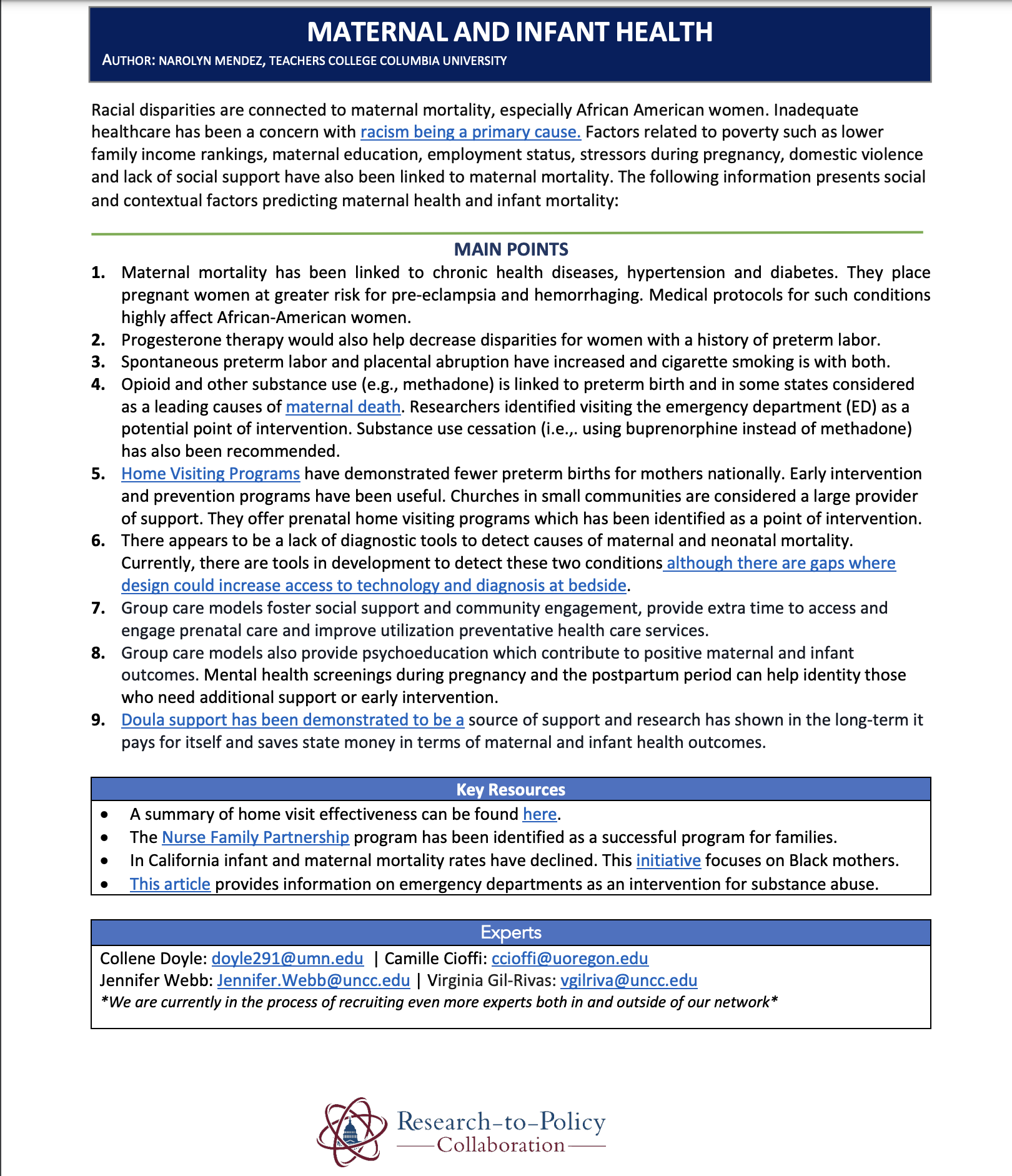
Racial disparities are connected to maternal mortality, especially African American women. Inadequate healthcare has been a concern with racism being a primary cause. Factors related to poverty such as lower family income rankings, maternal education, employment status, stressors during pregnancy, domestic violence and lack of social support have also been linked to maternal mortality. The following information presents social and contextual factors predicting maternal health and infant mortality:
Main Points
- Maternal mortality has been linked to chronic health diseases, hypertension and diabetes. They place pregnant women at greater risk for pre-eclampsia and hemorrhaging. Medical protocols for such conditions highly affect African-American women.
- Progesterone therapy would also help decrease disparities for women with a history of preterm labor.
- Spontaneous preterm labor and placental abruption have increased and cigarette smoking is with both.
- Opioid and other substance use (e.g., methadone) is linked to preterm birth and in some states considered as a leading causes of maternal death. Researchers identified visiting the emergency department (ED) as a potential point of intervention. Substance use cessation (i.e.,. using buprenorphine instead of methadone) has also been recommended.
- Home Visiting Programs have demonstrated fewer preterm births for mothers nationally. Early intervention and prevention programs have been useful. Churches in small communities are considered a large provider of support. They offer prenatal home visiting programs which has been identified as a point of intervention.
- There appears to be a lack of diagnostic tools to detect causes of maternal and neonatal mortality. Currently, there are tools in development to detect these two conditions although there are gaps where design could increase access to technology and diagnosis at bedside.
- Group care models foster social support and community engagement, provide extra time to access and engage prenatal care and improve utilization preventative health care services.
- Group care models also provide psycho-education which contribute to positive maternal and infant outcomes. Mental health screenings during pregnancy and the postpartum period can help identity those who need additional support or early intervention.
- Doula support has been demonstrated to be a source of support and research has shown in the long-term it pays for itself and saves state money in terms of maternal and infant health outcomes.
Key Resources
- A summary of home visit effectiveness can be found here.
- The Nurse Family Partnership program has been identified as a successful program for families.
- In California infant and maternal mortality rates have declined. This initiative focuses on Black mothers.
- This article provides information on emergency departments as an intervention for substance abuse.
The Research-to-Policy Collaboration (RPC) works to bring together research professionals and public officials to support evidence-based policy. Please visit their website to learn more.
Key Information
RPC Website
Research-to-Policy Collaboration
More RPC Resources
RPC Resources
Publication DateSeptember 21, 2019
Topic Area(s)Health
Resource TypeWritten Briefs
Share This Page
Racial disparities are connected to maternal mortality, especially African American women. Inadequate healthcare has been a concern with racism being a primary cause. Factors related to poverty such as lower family income rankings, maternal education, employment status, stressors during pregnancy, domestic violence and lack of social support have also been linked to maternal mortality. The following information presents social and contextual factors predicting maternal health and infant mortality:
Main Points
- Maternal mortality has been linked to chronic health diseases, hypertension and diabetes. They place pregnant women at greater risk for pre-eclampsia and hemorrhaging. Medical protocols for such conditions highly affect African-American women.
- Progesterone therapy would also help decrease disparities for women with a history of preterm labor.
- Spontaneous preterm labor and placental abruption have increased and cigarette smoking is with both.
- Opioid and other substance use (e.g., methadone) is linked to preterm birth and in some states considered as a leading causes of maternal death. Researchers identified visiting the emergency department (ED) as a potential point of intervention. Substance use cessation (i.e.,. using buprenorphine instead of methadone) has also been recommended.
- Home Visiting Programs have demonstrated fewer preterm births for mothers nationally. Early intervention and prevention programs have been useful. Churches in small communities are considered a large provider of support. They offer prenatal home visiting programs which has been identified as a point of intervention.
- There appears to be a lack of diagnostic tools to detect causes of maternal and neonatal mortality. Currently, there are tools in development to detect these two conditions although there are gaps where design could increase access to technology and diagnosis at bedside.
- Group care models foster social support and community engagement, provide extra time to access and engage prenatal care and improve utilization preventative health care services.
- Group care models also provide psycho-education which contribute to positive maternal and infant outcomes. Mental health screenings during pregnancy and the postpartum period can help identity those who need additional support or early intervention.
- Doula support has been demonstrated to be a source of support and research has shown in the long-term it pays for itself and saves state money in terms of maternal and infant health outcomes.
Key Resources
- A summary of home visit effectiveness can be found here.
- The Nurse Family Partnership program has been identified as a successful program for families.
- In California infant and maternal mortality rates have declined. This initiative focuses on Black mothers.
- This article provides information on emergency departments as an intervention for substance abuse.
The Research-to-Policy Collaboration (RPC) works to bring together research professionals and public officials to support evidence-based policy. Please visit their website to learn more.

Key Information
RPC Website
Research-to-Policy Collaboration
More RPC Resources
RPC Resources
Publication DateSeptember 21, 2019
Topic Area(s)Health
Resource TypeWritten Briefs
Share This Page
LET’S STAY IN TOUCH
Join the Evidence-to-Impact Mailing List
Keep up to date with the latest resources, events, and news from the EIC.




